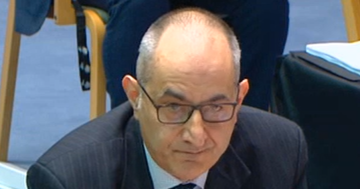Ben Hurley* looks at how to justify buying and keeping defensive investments before they’re needed.
 Defensive investments are easy to justify retrospectively when markets run into turmoil, but putting them in place when times are good – and keeping them there despite their cost – requires ongoing education and some deft diplomacy, experts say.
Defensive investments are easy to justify retrospectively when markets run into turmoil, but putting them in place when times are good – and keeping them there despite their cost – requires ongoing education and some deft diplomacy, experts say.
Presenting research in a panel discussion on strategies to protect portfolios during market downturns, James Murray, senior portfolio manager at TCorp, said to deliver an improved outcome during a downturn “you do need to take quite a lot of basis risk relative to peer benchmarks”.
Paying to protect a portfolio, either by explicit costs such as hedging or by the opportunity costs of defensive plays, “requires ongoing deep engagement with the fund’s governance committee(s),” Murray said.
“It’s a difficult conversation and it really has to start with what’s the need, and why do we have it within the portfolio.”
Challenge to exit
Speaking in a panel discussion at Conexus Financial’s Fiduciary Investors Symposium held in June in the Blue Mountains, Murray said it can be a challenge to retain defensive programs “even for clients where the need for this is unambiguously clear as in the case of funds confronted with very large sequencing risk”.
Murray said it can also be particularly difficult to exit these programs when they have fulfilled their defensive function in a downturn.
Assets aimed at smoothing a portfolio or providing counter-cyclical cash flow are not always “definitionally long-term,” and this throws up choices funds have to make ahead of time about when they are going to monetise them.
Panel chair Seamus Collins, chief investment officer at Mine Super, shared an anecdote with a fund that had an overlay strategy that was “very programmatic, it was very rigid, and that was deliberate because they didn’t feel they had the governance to trade around the strategy”.
Josh Heller, head of solutions at CIP Asset Management said it is critical when setting up defensive programs to highlight the exit is just as important as the entry.
“So understanding what your exit strategy is going to be, when you’re going to exit and actually having that as part of the program,” Heller said.
As the technology around some of these strategies has increased, CIP has systematised a number of those decisions, creating rules-based strategies that say “if it hits this, you take the money off the table,” he said.
Larger funds, on the other hand, tend to have more delegated authority and the ability take more complex decisions themselves, he said.
Collins asked if there was a different client response to explicit costs versus opportunity costs.
Heller said it comes down to understanding the differences between those strategies.
But it should be clear that the fund is not actually “paying explicit money out the door”.
“You are still purchasing an asset,” Heller said.
“So, when you pay 50 basis points for that protection, you receive an asset that’s worth 50 basis points.
“It’s not like your portfolio immediately draws down by 50 basis points and you’re sitting there on a loss.
“You have an asset that has value.”
Demonstrate benefit
Tom Leake, head of solutions at Capstone Investment Advisors, said when selling a strategy to a board, make sure you don’t ever just show the strategy.
Show the cost and the benefit together, and make sure everyone remembers the benefit they are getting.
“Your board should get used to seeing a slide that has those two things,” Leake said.
“So if you did it because you wanted to change the probability of having a significant loss, make sure you show…the probability of having that loss with the hedges, and show the probability of having that loss without the hedges.”
“Without showing the strategy, “people forget why they did it,” Leake said.
“And with boards turning over with time, re-education is important to ensure the new members continue to understand the strategy, to avoid “rushing to educate” when the investment is being reviewed, “because you do need to be able to hold it to get the benefit”.
*Ben Hurley is a journalist and editor with more than a decade of experience in the industry.
This article first appeared at investmentmagazine.com.au.









